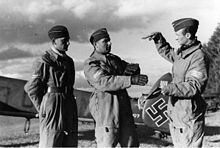Johann Schalk
Johann Schalk | |
|---|---|
 Johann Schalk (center) and Theodor Rossiwall (right) | |
| Allegiance | |
| Service/ | |
| Years of service | 1922–1945 |
| Rank | Oberst |
| Unit | ZG 26, NJG 3, NJG 4 |
| Battles/wars | World War II |
| Awards | Knight's Cross of the Iron Cross |
Johann (Hans) Schalk[Notes 1] (19 September 1903 – 9 November 1987) was a flying ace and high ranking officer in the German Luftwaffe during World War II. He is credited with 15 aerial victories, 4 of which on the Eastern front, claimed in 163 combat missions.[3]
Military career
Johann Schalk joined the Austrian Bundesheer in 1922 and as a Leutnant was trained to fly in 1928. He became a leader of a fighter squadron in August 1933 and was appointed commander of the Austrian Jagdgruppe 1 (1st fighter group).[3]
He was one of the best Austrian aerobatic pilots and gained experience at various delegations to Germany and Italy. After the Anschluss, the annexation of Austria and the integration of the Bundesheer into the German Wehrmacht, Schalk became Gruppenkommandeur (group commander) of the IV./Jagdgeschwader 134 (4th group of fighter wing 134) on 1 August 1938. This unit was later renamed and became the nucleus of III./Zerstörergeschwader 26 (ZG 26—destroyer wing 26) on 1 May 1939.[3]
Schalk claimed five aerial victories during the Battle of France and six during the Battle of Britain, three of which were shot down by his wireless radio operator Unteroffizier Scheuplein. He was one of the first members of the Luftwaffe to receive the Ehrenpokal der Luftwaffe and the first Zerstörer (destroyer) pilot to receive the Knight's Cross of the Iron Cross (Ritterkreuz des Eisernen Kreuzes) on 11 September 1940 after nine aerial victories.[3]
Awards
- Iron Cross (1939) 2nd and 1st class
- Ehrenpokal der Luftwaffe (21 August 1940)[3]
- Knight's Cross of the Iron Cross on 5 September 1940 as Oberstleutnant and Gruppenkommandeur of the III./ZG 26 "Horst Wessel"[1][2]
Notes
References
- Citations
- Bibliography
- Fellgiebel, Walther-Peer (2000). Die Träger des Ritterkreuzes des Eisernen Kreuzes 1939-1945. Friedburg, Germany: Podzun-Pallas. ISBN 3-7909-0284-5.
- Obermaier, Ernst (1989). Die Ritterkreuzträger der Luftwaffe Jagdflieger 1939 - 1945 (in German). Mainz, Germany: Verlag Dieter Hoffmann. ISBN 3-87341-065-6.
- Scherzer, Veit (2007). Die Ritterkreuzträger 1939–1945 Die Inhaber des Ritterkreuzes des Eisernen Kreuzes 1939 von Heer, Luftwaffe, Kriegsmarine, Waffen-SS, Volkssturm sowie mit Deutschland verbündeter Streitkräfte nach den Unterlagen des Bundesarchives (in German). Jena, Germany: Scherzers Miltaer-Verlag. ISBN 978-3-938845-17-2.
- Weal, John (1999). Messerschmitt Bf 110 Zerstörer Aces of World War 2. Osprey Publishing. ISBN 1855327538.
